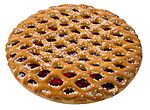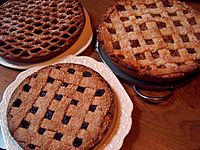Vlaai facts for kids

A cherry vlaai
|
|
| Course | Dessert |
|---|---|
| Place of origin | |
| Region or state | Limburg |
| Main ingredients | Yeast dough, fruits, berries |
Limburgse vlaai (Limburgish: vlaai, vlaoj or flaai. Plural: vlaaien) is a pastry consisting of a dough and filling, traditionally associated with the provinces of Limburg found both in the Netherlands and Belgium, as well as the parts of Germany across the border.
Variations exist throughout the Netherlands, Belgium and areas of the German state North Rhine-Westphalia near to the border with the Netherlands. A vlaai is usually 26—31 centimetres in diameter. It is available in many different varieties of fruit fillings, such as cherry, apricot, strawberries, and plums. Other variations are a crumbled butter and sugar mix ("greumellevlaai" in Limburgish, or "kruimelvlaai" in Dutch) and a cooked rice and custard porridge ("rijstevlaai").
Vlaai is often eaten on special occasions and significant life events, particularly in the Dutch province of Limburg, such as birthdays and funerals. When eaten on the occasion of a funeral, the vlaai is typically made with black plum ("Zwarte pruimenvlaai").
History
There is little known about the history of vlaaien that can be said for sure, except that they're not a purely Limburgish pastry.
One of the oldest mentions of vlaaien dates from the 12th century during the siege of the city Sint-Truiden located in Belgium in 1189. During the siege by duke Godfried III van Leuven the inhabitants of the city offered him a vlaai that was baked following old local recipes. According to a mention from abbot Nicolaas in the chronicle from the abbey of Sint-Truiden the duke stopped the siege soon after.
Until the mid 20th century the vlaai was considered a luxury item in Limburg, that would only be eaten during celebrations. On the countryside they were almost always baked by the people themselves, usually in traditional bakehouses. The vlaaien would get served around four in the afternoon during the coffee break, with usually two or three different slices per person. Because of the growing economic prosperity after the second World War people started eating them more often.
The vlaaien started getting more widely known outside of Limburg during the late 19th century mostly because of growing tourism in Dutch Southern Limburg. A lot of tourists took a vlaai with them back home from local bakers. In 1986 the first vlaaien shop opened in Amsterdam. The selling of vlaaien by several supermarket chains also helped popularizing the pastry. Maria Hubertina Hendrix, also known as 'Antje van de Stasie', also helped spreading the popularity outside of Limburg. She sold in the early 20th century her 'Weerter vlaaitjes' at the train station in Weert, this caused the pastry to become well known by travellers from all over the Netherlands. After a while the Weerter vlaaien were also sold in Nijmegen. She has had a statue in Weert since 1988.
See also
 In Spanish: Vlaai para niños
In Spanish: Vlaai para niños


